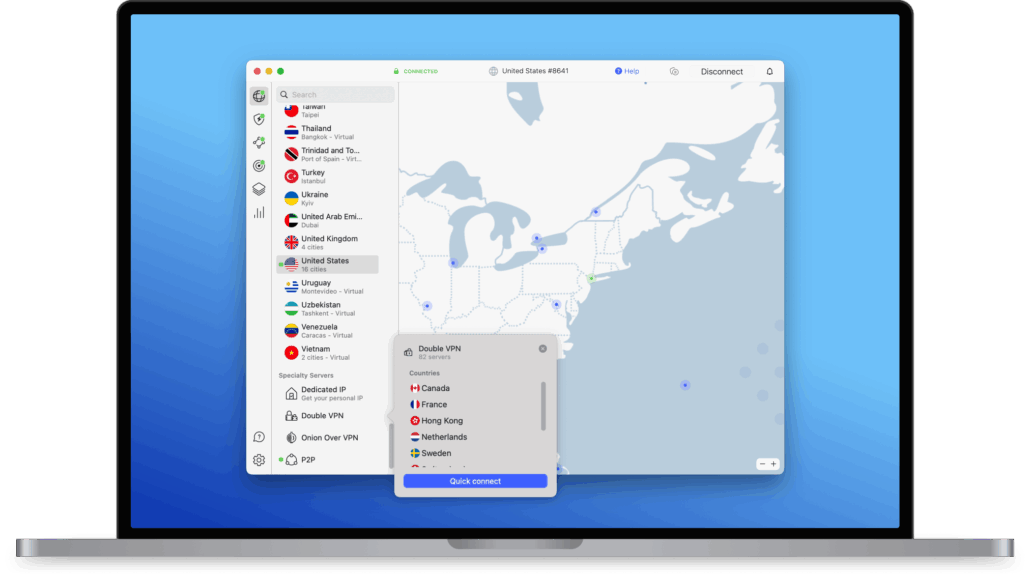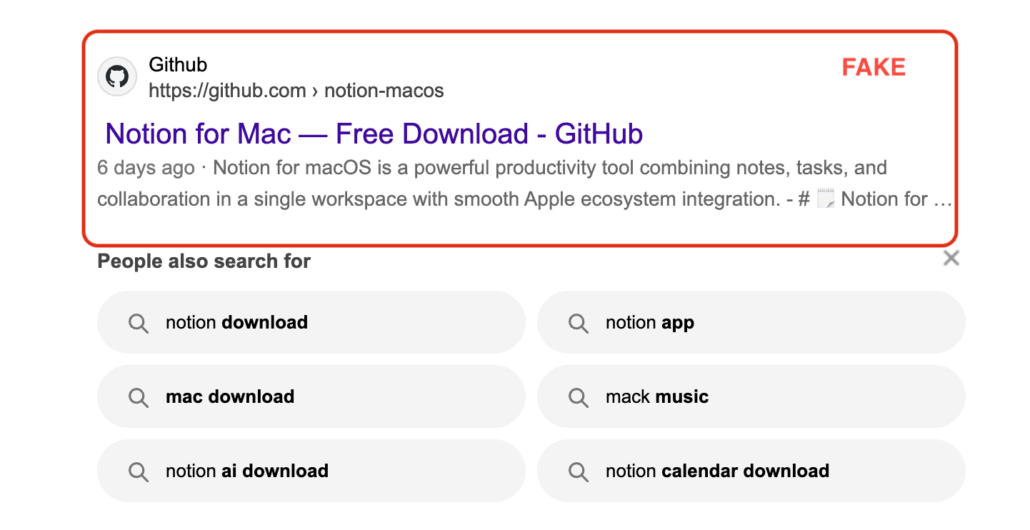Published: October 4, 2025 | Last updated: October 4, 2025
Key Takeaway: Modern centrally managed network systems transform small business IT from reactive troubleshooting to proactive monitoring. This guide compares five leading platforms—UniFi, Cisco Meraki, TP-Link Omada, Zyxel Nebula, and Firewalla—helping you choose the right cloud-managed solution for your business based on budget, technical requirements, and operational needs.
Why Centrally Managed Networks Matter for Small Businesses
Network management has evolved dramatically over the past decade. When we started installing networks for small businesses in South Florida, the typical setup was straightforward: connect the ISP router to an unmanaged switch, add a few access points, and call it a day. For businesses with 5-10 employees, this approach worked—until something went wrong.
The fundamental problem with unmanaged networks became clear during our first few years of support work. When a client experienced connectivity issues, we had no visibility into what was happening. Was it the switch? An access point? A bad cable? The ISP connection? Every troubleshooting session required an on-site visit, turning a potential 10-minute remote fix into a 2-hour truck roll.
More importantly, we couldn't perform proactive monitoring. Problems often escalated from minor issues—like a failing switch port or an overloaded access point—into complete network outages before anyone noticed. This reactive approach to IT support was inefficient for us and frustrating for our clients.
Centrally managed network platforms changed everything. With cloud-based dashboards, we can monitor network health from anywhere, receive alerts before problems impact users, and troubleshoot most issues remotely. The visibility alone has transformed how we deliver IT support, reducing on-site visits by approximately 60% while improving overall network reliability.
Important Context
This guide focuses on solutions appropriate for small to medium businesses (5-100 employees) with office locations. While we primarily deploy UniFi systems, we've evaluated all platforms discussed here through hands-on testing, client deployments, or detailed research. Our recommendations are based on real-world implementation experience, not theoretical analysis.
Quick Reference: Platform Comparison Overview
Before diving into detailed analysis, here's a high-level comparison to help you navigate this guide:
| Platform | Best For | Starting Price Range | Cloud Fee |
|---|---|---|---|
| UniFi | Value-focused businesses, scalability, and no licensing | $129-$599 gateway + equipment | None |
| Cisco Meraki | Enterprise features, established IT teams, and compliance requirements | $640+ gateway + equipment | $150-400/device/year |
| TP-Link Omada | Budget-conscious, UniFi alternative, DIY installation | $60-$350 controller + equipment | None |
| Zyxel Nebula | MSP deployments, multi-tenant management, and established brands | $200-$500 gateway + equipment | None (free tier), paid for advanced |
| Firewalla | Security-first approach, privacy-focused, home office | $249-$889 gateway only | None |
Jump to Platform Details:
- UniFi: Our Primary Recommendation
- Cisco Meraki: Enterprise Standard
- TP-Link Omada: Budget Alternative
- Zyxel Nebula: MSP Friendly
- Firewalla: Security Focus
Understanding Centrally Managed Networks
What Makes a Network “Centrally Managed”?
A centrally managed network system consists of network hardware (routers, switches, access points) controlled through a single management interface—typically a cloud-based dashboard accessible from anywhere with internet access. This contrasts with traditional networks, where each device requires individual configuration through its own interface.
The core components include:
1. Management Platform
The central control system, usually cloud-hosted, provides the unified interface for configuring all devices, monitoring network health, and generating reports. Some platforms offer on-premises controllers as alternatives.
2. Network Gateway/Router
The primary device connecting your network to the Internet handles routing, firewall rules, and often advanced features like VPN connections, intrusion prevention, and quality of service (QoS) policies.
3. Managed Switches
Network switches in the management dashboard allow you to configure VLANs, port settings, power-over-Ethernet (PoE) budgets, and monitor port status and utilization.
4. Access Points
WiFi access points that coordinate through the controller for seamless roaming, centralized configuration, and comprehensive coverage analytics.
The Business Value of Central Management
The transformation from unmanaged to managed networks delivers measurable operational benefits:
Remote Troubleshooting Capability
When a user reports connectivity issues, you can immediately check network health, identify which device or link is experiencing problems, and often resolve issues without dispatching a technician. Based on our client deployments, this alone reduces IT support costs by 40-60%.
Proactive Monitoring and Alerts
Rather than learning about network problems when users complain, managed systems alert you to issues like failing hardware, bandwidth congestion, or unusual traffic patterns before they impact operations. We typically catch and resolve 3-4 potential issues monthly before clients notice them.
Simplified Multi-Site Management
Businesses with multiple locations can monitor and configure all networks from a single dashboard. Instead of managing 5 separate networks with 5 different logins, you view everything in one interface.
Network-Wide Configuration Changes
Let's say you need to update WiFi passwords, adjust firewall rules, or implement new security policies. Instead of configuring each device individually, push changes across all devices simultaneously.
Historical Analytics and Planning
Detailed usage data helps with capacity planning, troubleshooting recurring issues, and justifying infrastructure investments with concrete utilization metrics.
Key Features to Evaluate
When comparing centrally managed network platforms, these capabilities matter most for small business deployments:
Essential Platform Capabilities:
- Zero-Touch Provisioning: New devices automatically connect to your account and download configurations
- VLAN Support: Network segmentation for security, guest networks, and IoT devices
- Wireless Mesh: Access points that can wirelessly connect to extend coverage
- Client Device Visibility: See all connected devices, their locations, and bandwidth usage
- Mobile App Management: Monitor and configure networks from smartphone apps
- API Access: Integration with monitoring systems and automation platforms
- Firmware Management: Centralized updates with rollback capabilities
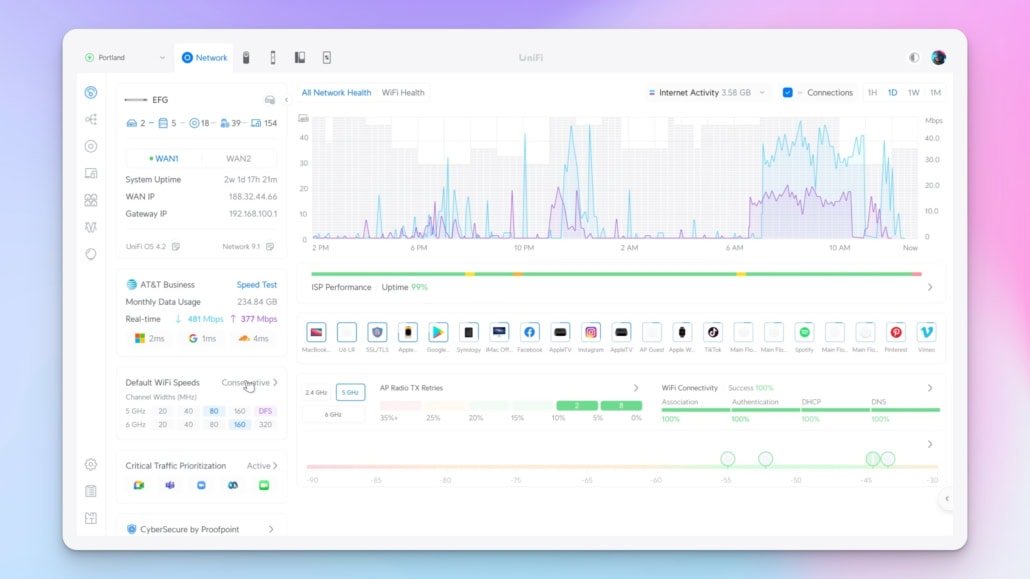
UniFi: Comprehensive Platform Analysis
Our Primary Recommendation
Over the past four years, we've deployed UniFi systems in 50+ business environments, establishing it as our go-to platform for small to medium business networks. The combination of professional-grade features, reasonable pricing, zero licensing fees, and a comprehensive ecosystem makes UniFi the best value proposition for most scenarios.
Platform Overview
UniFi, developed by Ubiquiti Networks, offers a complete network ecosystem managed through its cloud-based Network application (formerly “Controller”). The platform includes gateways, switches, access points, cameras, access control systems, and even phone systems—all managed from a unified interface.
UniFi's pricing model is the key differentiator: you purchase hardware once with no recurring licensing fees. This contrasts sharply with enterprise platforms like Cisco Meraki, where annual licenses can exceed the initial hardware cost.
Hardware Ecosystem
Gateway Options
UniFi offers several gateway models appropriate for business deployments. Our standard installations focus on two primary options based on physical space and infrastructure requirements:
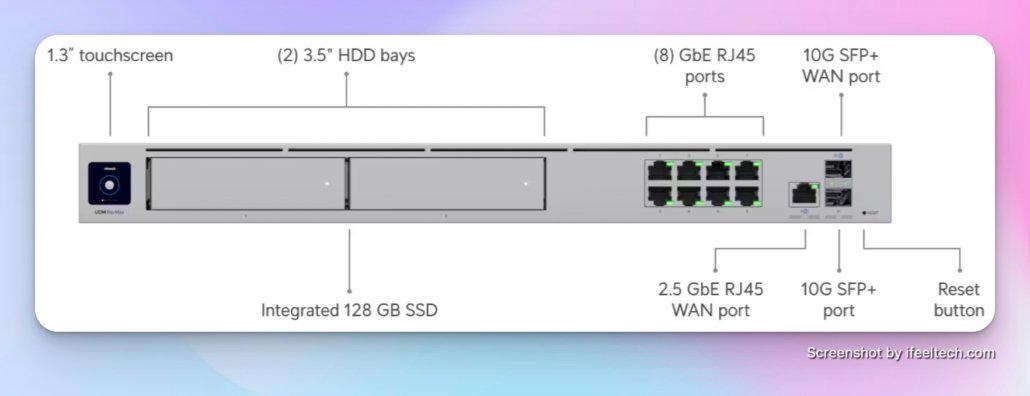
UniFi Dream Machine Pro Max ($599) is our primary recommendation for businesses with proper network racks. This enterprise-class gateway delivers dual 10G SFP+ and 2.5G RJ45 WAN ports, 5 Gbps IDS/IPS throughput, integrated LAN connectivity, and a built-in 8-port switch. The included 128GB SSD supports UniFi Protect camera recording and is expandable with 3.5″ drives. We deploy this model for most professional installations because it provides comprehensive capabilities, room for growth, and the performance headroom businesses need as they scale.
UniFi Cloud Gateway Max ($199) works well for smaller companies with limited space or budget constraints. This compact gateway provides 2.3 Gbps routing with IDS/IPS, a 2.5 GbE WAN port, and can manage over 30 UniFi devices and 300+ clients, making it effective for offices with 10-25 employees. The desktop form factor sits discreetly in offices without requiring rack infrastructure.
The Enterprise Fortress Gateway (EFG) ($1,999) is the top of the UniFi lineup, delivering redundant power and 10G SFP+ WAN/LAN ports for high-availability scenarios. We deploy this appliance for specialized scenarios requiring exceptional performance and uptime—data centers, large office complexes, or environments with substantial traffic loads. Most small to medium businesses will not need this level of capability.
Switching Portfolio
UniFi's switch lineup spans from desktop models to enterprise aggregation switches. Our installations typically focus on the Pro and Enterprise series, selected to provide growth capacity without requiring equipment replacement as businesses expand:
Standard Gigabit Switches
UniFi Switch Pro 24 PoE ($699) provides 24 gigabit ports with a 400W PoE+ and PoE++ budget and 10G SFP+ uplinks, sufficient for powering numerous access points, IP cameras, and other PoE devices. We deploy this model for most small to medium-sized office installations.
UniFi Switch Pro 48 PoE ($1,099) doubles port density with a 600W PoE budget. This model serves larger offices or deployments with extensive PoE device requirements, providing expansion capacity without daisy-chaining multiple switches.
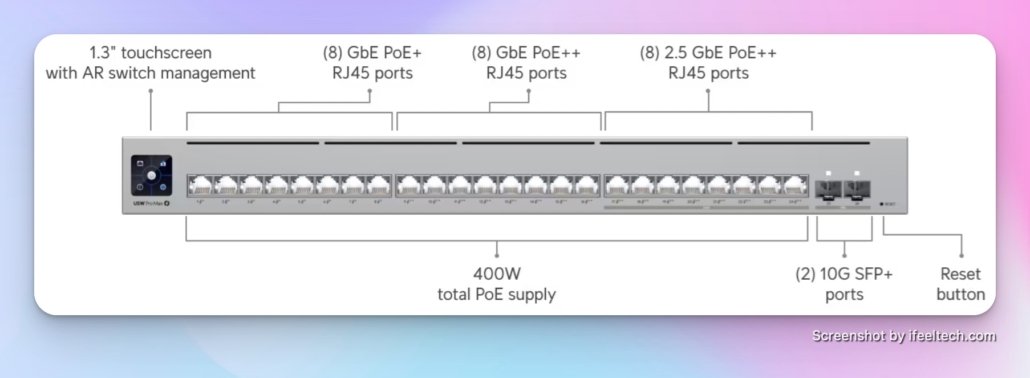
Multi-Gigabit Switches
Pro Max 24 PoE ($799) offers 2.5 GbE ports and PoE++, ideal for connecting high-performance WiFi 7 access points.
UniFi Pro XG 24 ($1,799) A professional-grade 24-port Layer 3 Etherlighting™ PoE+++ switch featuring 16 10 GbE ports, 8 2.5 GbE ports, and 2 25G SFP28 ports.
Our standard approach oversizes switch capacity by approximately 30% to accommodate business growth without hardware replacement. A 20-person office receives a 24-port switch even if current requirements only justify 16 ports—the modest additional cost prevents infrastructure constraints as companies expand.
Access Point Lineup
UniFi's WiFi portfolio expanded significantly with the introduction of WiFi 7. Our installations emphasize current models providing maximum performance and longevity:
UniFi Access Point U7 Pro ($189) represents our primary deployment choice for professional environments. This ceiling-mounted WiFi 7 access point features a 2.5 GbE uplink, ensuring wireless performance isn't constrained by wired connectivity. It supports over 300 clients and provides excellent coverage in both high-density conference rooms and standard office environments. We deploy this model when future-proofing justifies the investment—the WiFi 7 standard will serve businesses effectively for 5-7 years.
UniFi Access Point U7 Pro XG ($199) High-performance WiFi 7 access point with 6 spatial streams and 10 GbE uplink support. With the same sleek, redesigned form factor, it provides an excellent balance of performance and cost-effectiveness for most business applications.
For comprehensive WiFi 7 planning guidance, reference our professional WiFi 7 implementation guide.
Management Platform
The UniFi Network application provides comprehensive network management through a web interface or mobile apps. Key capabilities include:
Dashboard and Monitoring
The main dashboard displays network health at a glance: active clients, throughput statistics, ISP status, and device health. Color-coded status indicators make it easy to spot issues quickly. Historical graphs show bandwidth utilization patterns, helping identify congestion periods or unusual traffic spikes.
Device Management
All network devices appear in a unified topology view, showing how equipment connects and its current status. Click any device to view detailed statistics, configure settings, or perform actions like rebooting or upgrading firmware.
Client Management
You can view every device connected to your network with details, including device type, manufacturer, signal strength, and bandwidth usage. You can also create custom names for devices, assign them to specific networks, or limit bandwidth for troublesome clients.
Network Configuration
Create multiple networks (VLANs) for segmenting traffic—guest WiFi, IoT devices, IP cameras, or departments. Configure firewall rules to control traffic between networks. Set up VPN connections for remote access or site-to-site connectivity.
WiFi Management
Configure SSID names, passwords, and security settings once, then push them to all access points. Enable features like fast roaming for seamless connections as users move between access points. Create WiFi schedules to disable guest networks during off-hours.
Real-World Implementation Experience
Our typical UniFi deployment for a 25-person office with rack infrastructure consists of:
- UniFi Dream Machine Pro Max ($599)
- UniFi Switch Pro 24 PoE ($699)
- 4x UniFi U7 Pro Access Points ($189 each = $756)
Total equipment cost: approximately $2,054 for enterprise-grade managed infrastructure with no recurring licensing fees.
For smaller businesses without rack space, an alternative configuration:
- UniFi Cloud Gateway Max ($199)
- UniFi Switch Lite 16 PoE ($199)
- 3x UniFi U7 Pro Access Points ($189 each = $567)
Total equipment cost: approximately $965 for a complete WiFi 7 deployment supporting 15-20 employees.
These configurations reflect our actual installation practices—we prioritize current-generation access points and appropriately sized switching infrastructure to ensure networks remain capable as businesses grow.
For comprehensive planning guidance, reference our professional UniFi network design guide.
Advantages and Limitations
What UniFi Does Exceptionally Well:
- No Licensing Fees: Pay once for hardware, use forever with full features
- Comprehensive Ecosystem: Single platform for networking, cameras, access control, and phones
- Professional Features: VLANs, advanced routing, IDS/IPS, VPN, and extensive firewall controls
- Excellent Value: Enterprise-class capabilities at prosumer pricing
- Strong Community: Large user base provides extensive documentation and troubleshooting resources
- Regular Updates: Continuous feature additions and improvements through firmware updates
Where UniFi Has Limitations:
- Learning Curve: More complex than consumer routers, requires networking knowledge for optimal configuration
- Support Structure: No phone support—relies on community forums and ticket system
- Beta Features: Some advanced features remain in “beta” for extended periods
- Hardware Dependencies: Requires a compatible gateway/controller to manage network devices
Cisco Meraki: The Enterprise Benchmark
Cisco Meraki represents the established enterprise approach to centrally managed networking. Acquired by Cisco Systems in 2012, Meraki brought cloud-managed networking to the enterprise market before competing platforms gained traction.
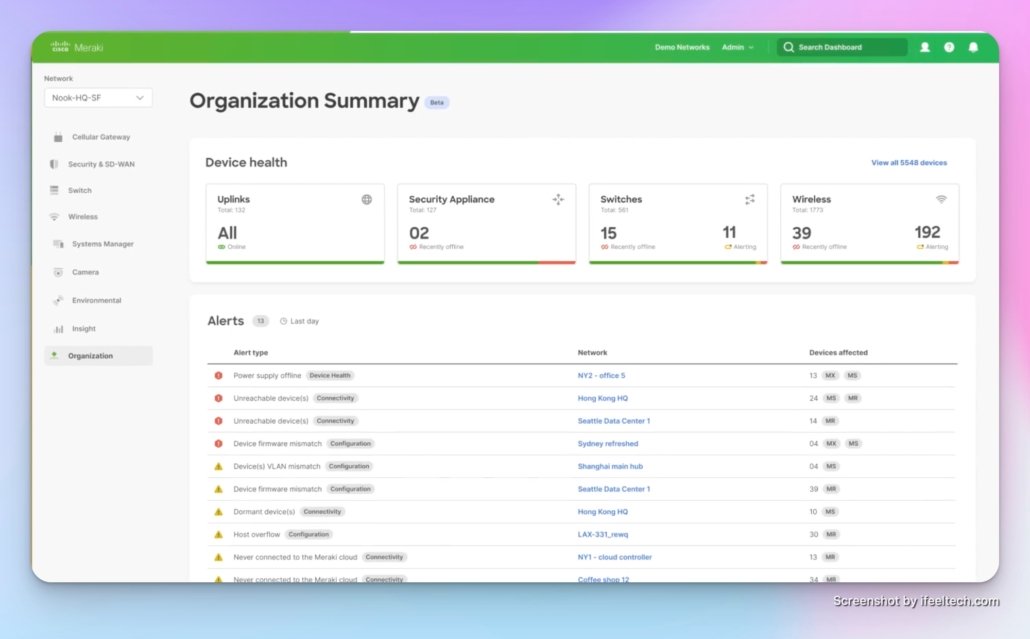
Platform Overview
Meraki's dashboard-centric management provides comprehensive control over security appliances, switches, access points, cameras, and sensors. The platform emphasizes simplicity and reliability, with Cisco's enterprise backing providing confidence for compliance-sensitive environments.
The significant difference from UniFi lies in Meraki's licensing model: every device requires an active license for operation. When licenses expire, devices stop functioning. This subscription approach generates recurring revenue for Cisco but creates ongoing costs for customers.
Hardware Portfolio
Security Appliances
Meraki's MX security appliances range from small office models to enterprise data center devices. The MX75 (approx. $640 + ~$430/year license) serves small business needs with 1 Gbps firewall throughput. The MX95 (approx. $3,800 + ~$1,500/year license) handles larger deployments with 3 Gbps firewall throughput and 10G interfaces.
Switches
Meraki switches start with models like the MS130-24P (approx. $1,570 + ~$250/year license) for installations requiring 24 gigabit PoE+ ports and scale to higher-end series for enterprise deployments.
Access Points
WiFi 6E access points like the MR57 (approx. $1,880 + ~$300/year license) deliver current wireless standards with Meraki's advanced radio resource management.
Management Dashboard
The Meraki Dashboard provides intuitive network management emphasizing visibility and reporting:
Organization-Wide Visibility
View all networks across multiple locations from a single interface. Compare performance metrics between sites, identify trends, and manage configurations centrally.
Change Management
Schedule configuration changes to deploy during maintenance windows. Track change history with audit logs showing who made changes and when.
Client Tracking
Meraki's client tracking provides detailed device history, showing connection patterns, roaming behavior, and application usage across time.
Application Performance
Layer 7 traffic shaping identifies applications consuming bandwidth. Generate reports showing how users spend time on the network, useful for both capacity planning and policy decisions.
Total Cost of Ownership Analysis
A comparable 20-person office deployment with Meraki:
- MX75 Security Appliance: $640 + $430/year
- MS130-24P Switch: $1,570 + $250/year
- 3x MR46 Access Points (WiFi 6): ~$2,400 ($800 ea) + $450/year total ($150 ea)
Initial Cost: ~$4,610
Annual Licensing: ~$1,130
Five-Year Total: ~$10,260
Compared to UniFi's one-time ~$2,054 investment, the cost difference becomes substantial over time.
When Meraki Makes Sense
Meraki Is the Right Choice When:
- Enterprise Support Requirements: Your organization needs phone support with guaranteed response times
- Compliance Standards: Industries like healthcare or finance require vendor support documentation
- Integration Needs: Existing Cisco infrastructure benefits from unified management
- Large Multi-Site Deployments: Centralized IT managing dozens or hundreds of locations
- Budget Not Primary Concern: Total cost of ownership is acceptable given features and support
Consider Alternatives When:
- Budget Constraints: Ongoing licensing costs strain IT budgets
- Small Business Focus: Enterprise features exceed actual requirements
- Technical Capability: In-house expertise can handle less hand-holding
- License Management: Tracking renewal dates and budget approval creates an administrative burden
TP-Link Omada Cloud: The Value Option
TP-Link entered the business networking market with Omada, positioning the platform as an affordable alternative to UniFi with similar capabilities and a familiar management approach.
Platform Overview
Omada provides cloud-based management for TP-Link business networking equipment through either hardware controllers, software controllers, or their cloud service. The platform closely mirrors UniFi's feature set and interface design, making it familiar for anyone who's used Ubiquiti products.
The key selling point is price: Omada equipment typically costs 20-40% less than equivalent UniFi hardware while providing comparable functionality. Like UniFi, Omada has no licensing fees—purchase hardware once and manage it indefinitely.
Hardware Options
Gateways
The ER7206 ($140) provides a capable router for small deployments. The ER8411 ($399) steps up to 10 Gbps connectivity with a powerful quad-core CPU and advanced routing features.
Switches
Omada's switch lineup includes the TL-SG3428XMP ($570) with 24 PoE+ ports, a 384W power budget, and 10G SFP+ uplinks, comparable to UniFi's Pro switches at a lower cost.
Access Points
The EAP670 ($136) provides high-efficiency WiFi 6 at an attractive price point, while the EAP773 ($180) adds WiFi 7 support with a 10G Ethernet port. Performance in testing matches specifications, though the management interface can feel less polished than UniFi's.
Management Experience
Omada's controller interface looks remarkably similar to UniFi's, with a nearly identical layout and navigation. Basic configuration tasks are straightforward, and common features like VLAN creation, wireless profiles, and firewall rules work as expected.
However, some advanced features feel less mature. The traffic analytics are functional but less detailed than UniFi's comprehensive insights. Documentation quality trails UniFi's extensive knowledge base, and the community support network is smaller but growing.
Best Use Cases
Omada Excels For:
- Budget-Conscious Deployments: Smaller IT budgets requiring maximum value
- Simple Requirements: Basic managed networking without complex features
- DIY Installation: Tech-savvy business owners handling their own setup
- Backup Networks: Secondary sites where a premium investment isn't justified
- Testing Managed Networks: Low-risk way to experiment with centralized management
Consider UniFi Instead When:
- Long-Term Investment: Professional deployments where reliability and a polished UI matter more than initial cost
- Advanced Features: Need sophisticated traffic analysis, IDS/IPS, or custom firewall rules
- Ecosystem Value: Planning to add cameras, access control, or other integrated systems
- Support Requirements: Want larger community resources and better documentation
Zyxel Nebula: The MSP Platform
Zyxel's Nebula platform targets managed service providers (MSPs) and businesses wanting established brand recognition with cloud management capabilities.
Platform Overview
Nebula provides centralized management for Zyxel networking equipment through a cloud portal designed for multi-tenant deployments. The platform emphasizes MSP workflows, making it easy to manage multiple customer networks from a single dashboard.
Zyxel brings decades of networking experience to the cloud management space. The hardware quality is solid, and enterprise features like advanced routing protocols and comprehensive VLAN support match expectations for business-grade equipment.
Note: Zyxel's product line and pricing change frequently. Please verify current models and costs directly with a reseller before making a purchase decision.
Hardware Lineup
Security Gateways
The USG FLEX series ranges from compact models suitable for small offices to powerful appliances for demanding enterprise deployments. Performance specifications are competitive, though pricing sits between UniFi and Meraki.
Switches
Zyxel's managed switches include the XGS1930 series with multi-gigabit ports and the GS1920 series for standard gigabit needs. Build quality impresses, with solid metal construction and efficient cooling.
Access Points
Zyxel offers a range of WiFi 6 and WiFi 6E access points, such as the WAX640S-6E, delivering strong performance and stable connections in testing.
Licensing Model
Nebula offers a unique hybrid approach:
- Free Tier: Basic cloud management with limited features.
- Nebula Plus Pack: Annual license per device (approx. $20-$40/year) unlocking advanced features.
- Nebula Pro Pack: Annual license per device (approx. $35-$100/year) for premium features, analytics, and MSP tools.
This creates more predictable costs than Meraki while offering more features than the free tier provides.
MSP Focus
Nebula's multi-tenancy model allows service providers to manage multiple customer networks efficiently. Create separate organizations for each client, assign appropriate permissions to technicians, and generate per-customer reports for billing or documentation.
The MSP portal provides aggregate views across all customers, helping identify trends, plan capacity, and respond to issues quickly.
Market Position
Zyxel Nebula Works Well For:
- MSP Deployments: Managing multiple customer networks efficiently
- Brand Recognition: Organizations prefer established networking vendors
- Hybrid Approach: Want some premium features without full licensing costs
- Enterprise Features: Need advanced routing protocols or specific compliance requirements
Potential Concerns:
- Higher Hardware Costs: Equipment pricing often exceeds UniFi and Omada
- Smaller Community: Less user-generated content and troubleshooting resources
- Feature Licensing: Some key capabilities require paid packs
- Limited Ecosystem: Cameras and other add-ons use separate management platforms
Firewalla: The Security-First Appliance
Firewalla takes a different approach to network management, focusing primarily on security and privacy rather than comprehensive network infrastructure control.
Platform Overview
Firewalla devices function as security appliances sitting between your router and network, providing advanced threat detection, content filtering, VPN services, and detailed network monitoring. Rather than replacing your entire network infrastructure, Firewalla enhances existing equipment with security-focused management.
The company emphasizes privacy, with all processing happening locally on your device rather than in cloud-dependent services. Management through a mobile app provides convenient visibility and control without requiring cloud accounts or subscriptions.
Hardware Models
Firewalla Gold Plus ($599)
Features four 2.5 Gbps ports and a powerful quad-core processor. This is the sweet spot for most small business deployments with multi-gigabit internet connections.
Firewalla Gold SE ($479)
A newer, more affordable version of the Gold, providing multi-gigabit throughput and comprehensive security features suitable for home offices or small businesses.
Firewalla Gold Pro ($889)
It features dual 10 Gbps and dual 2.5 Gbps interfaces with 10+ Gbps inspection capacity. It is designed for prosumers and businesses with high-speed multi-gigabit internet connections.
Firewalla Purple SE ($249)
This compact model provides 500 Mbps inspection speed. It is suitable for smaller networks or as a travel router for secure connectivity on the go.
Security Features
Firewalla's strength lies in its security capabilities:
Intrusion Detection and Prevention
Advanced IDS/IPS monitors network traffic for threats and automatically blocks malicious connections. Regular signature updates keep protection current against emerging threats.
Content Filtering
Granular control over website access by category, time of day, or specific URLs. Useful for businesses wanting to enforce acceptable use policies.
VPN Services
A built-in VPN server allows secure remote access. VPN client capabilities let you route all business traffic through commercial VPN services for additional privacy.
Network Segmentation
Create isolated networks for IoT devices, guest access, or sensitive systems without requiring managed switches supporting VLANs.
Ad Blocking
Network-wide ad and tracker blocking reduces bandwidth consumption and improves privacy without installing software on individual devices.
Management Experience
The Firewalla mobile app provides comprehensive control in an intuitive interface. You can view real-time statistics, receive alerts about security events, and adjust configurations from your phone.
The app-centric design is powerful but may feel limiting for business deployments that require a traditional web interface for complex configurations. Some advanced settings require terminal access via SSH, which may intimidate non-technical users.
Deployment Considerations
Firewalla works best as a security layer complementing existing network infrastructure:
Ideal Scenarios for Firewalla:
- Home Office Security: Professionals wanting business-class protection at home
- Enhanced Existing Networks: Adding security features to basic network equipment
- Privacy Priority: Organizations emphasizing data privacy and local processing
- Simple Deployments: Small locations with straightforward requirements
- Segmentation Needs: Isolating IoT devices without VLAN-capable switches
Not Ideal For:
- Complete Infrastructure: Does not offer centrally managed switches and access points
- Enterprise Features: Lacks advanced routing, QoS, or complex firewall rules found in UniFi or Meraki
- Multi-Site Management: Not designed for managing multiple locations from a unified dashboard
- Large-Scale Deployments: Better suited for small office or home office environments
Platform Comparison and Decision Framework
Total Cost of Ownership: 5-Year Analysis
Understanding long-term costs helps make informed infrastructure decisions:
| Platform | Initial Hardware | Annual Licensing | 5-Year Total |
|---|---|---|---|
| UniFi | ~$2,054 | $0 | ~$2,054 |
| Omada | ~$1,300 | $0 | ~$1,300 |
| Zyxel Nebula | ~$1,500+ | ~$200-500 | ~$2,500-4,000+ |
| Firewalla | $599 + existing network | $0 | $599 + network |
| Cisco Meraki | ~$4,610 | ~$1,130 | ~$10,260 |
This is based on a typical 20-25-person office deployment: 1 gateway, 1 switch, and 3-4 access points. Costs are estimates and can vary.
Feature Comparison Matrix
| Feature | UniFi | Meraki | Omada | Zyxel | Firewalla |
|---|---|---|---|---|---|
| Cloud Management | ✓ | ✓ | ✓ | ✓ | Local |
| Mobile App | ✓ | ✓ | ✓ | ✓ | ✓ |
| VLAN Support | ✓ | ✓ | ✓ | ✓ | Basic |
| IDS/IPS | ✓ | ✓ | Limited | ✓ (Licensed) | ✓ |
| VPN Server | ✓ | ✓ | ✓ | ✓ | ✓ |
| Traffic Analytics | Excellent | Excellent | Good | Good (Licensed) | Excellent |
| Phone Support | – | ✓ | ✓ | ✓ | |
| Camera Integration | Native | Native | Native | Separate | – |
Decision Framework by Business Scenario
Scenario 1: New 15-Person Office, Value-Focused
→ Recommendation: UniFi
Best balance of features, cost, and capabilities without recurring fees. The single unified platform grows with business needs.
Scenario 2: Retail Chain with 8 Locations
→ Recommendation: Cisco Meraki
Multi-site management excels with Meraki's dashboard. Enterprise support and simple device replacement (zero-touch provisioning) justify licensing costs for production environments.
Scenario 3: Home-Based Consultant Requiring High Security
→ Recommendation: Firewalla
Security-first approach covers essential needs without infrastructure complexity. Adds a powerful security layer to any existing network.
Scenario 4: MSP Managing 30 Clients
→ Recommendation: Zyxel Nebula
Multi-tenant architecture streamlines customer management with a flexible and reasonable cost structure.
Scenario 5: Tech-Savvy Business Owner, Tight Budget
→ Recommendation: TP-Link Omada
Maximum value for basic managed networking. Suitable for DIY installation for those with networking knowledge.
Scenario 6: Healthcare Practice with Compliance Requirements
→ Recommendation: Cisco Meraki or UniFi
Meraki provides clear vendor support documentation for compliance audits. UniFi can be fully compliant but may require more hands-on configuration and third-party verification.
For additional context on small business security compliance requirements, including HIPAA and PCI considerations.
Professional Implementation Considerations
Regardless of platform choice, successful deployment requires planning:
Network Assessment
Document current infrastructure, identify pain points, measure bandwidth requirements, and map device locations before selecting equipment.
Proper Sizing
Don't underestimate growth. Businesses typically add 20-30% more devices within two years of a network deployment. Size the infrastructure accordingly.
Cable Infrastructure
Managed networks require proper cabling. Cat6A supports multi-gigabit speeds and PoE++. Our comprehensive cabling guide covers planning considerations.
Testing Before Production
Configure and test equipment in a lab environment before deploying to production networks. This identifies configuration issues without impacting operations.
Documentation
Document network design, configuration details, and troubleshooting procedures. Future IT staff will appreciate comprehensive records.
Training
Ensure someone on staff understands basic network management. Simple tasks like password changes shouldn't require external support.
Implementation Resources and Next Steps
Getting Started with UniFi
For businesses choosing UniFi as their managed network platform:
1. Review Design Fundamentals
Our professional UniFi network design guide covers comprehensive planning of modern office infrastructure.
2. Understand Common Challenges
Learn about six common UniFi installation challenges and professional solutions before starting deployment.
3. Evaluate Latest Technology
Consider whether WiFi 7 implementation makes sense for your specific requirements.
4. Explore Complete Solutions
Browse the UniFi product catalog for complete hardware options.
Professional Network Services
Our Miami-based team provides comprehensive network deployment and support services throughout South Florida:
Network Design and Installation
We handle complete network deployments from initial site survey through equipment configuration and testing. Our experience installing 50+ UniFi networks provides practical expertise that goes beyond manufacturer documentation.
Network Assessment
Evaluating existing infrastructure to determine whether a managed network investment makes sense for your specific situation. We provide honest recommendations based on actual needs, not sales quotas.
Troubleshooting and Optimization
When networks underperform or create frustration, we diagnose root causes and implement lasting solutions. Remote monitoring allows us to catch issues before they impact operations.
Security Implementation
Network security extends beyond enabling firewall features. We configure defense-in-depth strategies, including network segmentation, access controls, intrusion prevention, and monitoring systems. Our cybersecurity upgrade guide covers when businesses outgrow basic security measures.
Frequently Asked Questions
Can I mix equipment from different platforms?
While technically possible to use equipment from multiple vendors, you lose the primary benefit of centrally managed networks—unified visibility and control. Each platform requires a separate management interface, eliminating efficiency gains. Stick with one ecosystem for the best results.
What happens to Meraki equipment when licenses expire?
Meraki devices stop functioning when licenses expire—they don't degrade to limited functionality or basic features. They will no longer pass traffic. Plan license renewals carefully to avoid network outages.
How difficult is it to migrate from one platform to another?
Network migrations require careful planning but are manageable with proper preparation. The physical infrastructure (cabling, mounting locations) remains unchanged. The challenge lies in reconfiguring network settings, VLANs, firewall rules, and wireless profiles on the new platform. When properly planned, most migrations can be completed over a weekend with minimal business disruption.
Do I need a dedicated server to run the UniFi Network application?
No. Modern UniFi gateways like the Cloud Gateway Max and Dream Machine series include built-in controllers, eliminating the need for separate hardware. The application runs efficiently on the gateway itself, providing full functionality without additional cost or complexity.
What internet speed do I need for centrally managed networks to function?
Cloud management requires minimal bandwidth—typically under 1 Mbps for dashboard access and configuration changes. The management traffic is separate from your business's primary internet usage. Even locations with modest internet connections can effectively use cloud-managed platforms. Firewalla operates entirely locally and requires no cloud connectivity for management.
Can I manage the network myself, or do I need professional help?
It depends on complexity and your technical comfort level. Basic deployments with simple requirements (a single network, guest WiFi, standard firewall rules) are manageable for tech-savvy business owners following manufacturer documentation. More complex scenarios—multiple VLANs, advanced security policies, VPN configurations, or troubleshooting connectivity issues—benefit significantly from professional expertise. Many businesses start with a professional installation, then handle day-to-day management internally with expert support available when needed.
How long should managed network equipment last?
Quality managed network equipment typically provides 5-7 years of reliable service. Access points often need replacement first due to the evolution of WiFi standards—upgrading from WiFi 6 to WiFi 7 brings meaningful performance improvements. Switches and gateways last longer since wired network standards evolve more slowly. Plan for gradual refresh cycles rather than a complete infrastructure replacement. Our hardware refresh planning guide covers practical approaches to infrastructure lifecycle management.
What's the minimum network size that justifies centrally managed equipment?
Any business with 5+ employees benefits from managed networking—not necessarily for scale, but for visibility and remote troubleshooting capability. The ability to diagnose network issues remotely saves significant IT support time regardless of business size. However, very small deployments (home offices, 2-3 person businesses) may not justify the investment unless security or remote management are specific priorities.
Conclusion: Making the Right Platform Choice
Centrally managed networks transform IT operations from reactive troubleshooting to proactive monitoring and optimization. The visibility, control, and remote management capabilities justify the investment for virtually any business with a meaningful dependence on technology.
UniFi provides the optimal balance of professional features, reasonable pricing, and zero licensing fees for most small to medium businesses. The comprehensive ecosystem supports growth from basic networking through advanced requirements, including security cameras, access control, and phone systems—all managed from a unified interface.
Cisco Meraki serves enterprises needing vendor support, compliance documentation, or existing Cisco infrastructure integration. The higher cost delivers established enterprise backing and comprehensive support structures.
TP-Link Omada creates opportunities for budget-conscious businesses willing to sacrifice some polish for significant cost savings. The platform delivers functional managed networking at attractive price points.
Zyxel Nebula targets MSPs and organizations that value established brand recognition and flexible licensing models. The platform's multi-tenant architecture streamlines service provider operations.
Firewalla takes a security-first approach, enhancing existing networks with advanced threat detection and privacy-focused features. The platform works best for simpler deployments where security takes priority over comprehensive infrastructure management.
The right choice depends on your specific requirements, budget constraints, technical capabilities, and growth expectations. Our experience deploying these platforms in diverse business environments throughout South Florida provides a practical perspective that goes beyond manufacturer marketing. We're happy to discuss your specific situation and provide honest recommendations based on actual needs rather than platform preferences.
Whether you implement managed networking yourself or prefer professional assistance, the investment in centralized network management pays dividends through improved reliability, reduced downtime, and simplified troubleshooting—transforming network infrastructure from a source of frustration into a strategic business asset.
This guide reflects current market conditions and product availability as of October 2025. Network equipment and pricing evolve continually—verify specific models and costs before making purchasing decisions. For personalized recommendations based on your unique requirements, contact our team for a comprehensive network assessment.
Disclosure: iFeelTech participates in the Ubiquiti Creator Program. We may earn a commission when you purchase UniFi products through our links at no additional cost to you. Our recommendations are based on professional experience and testing.
